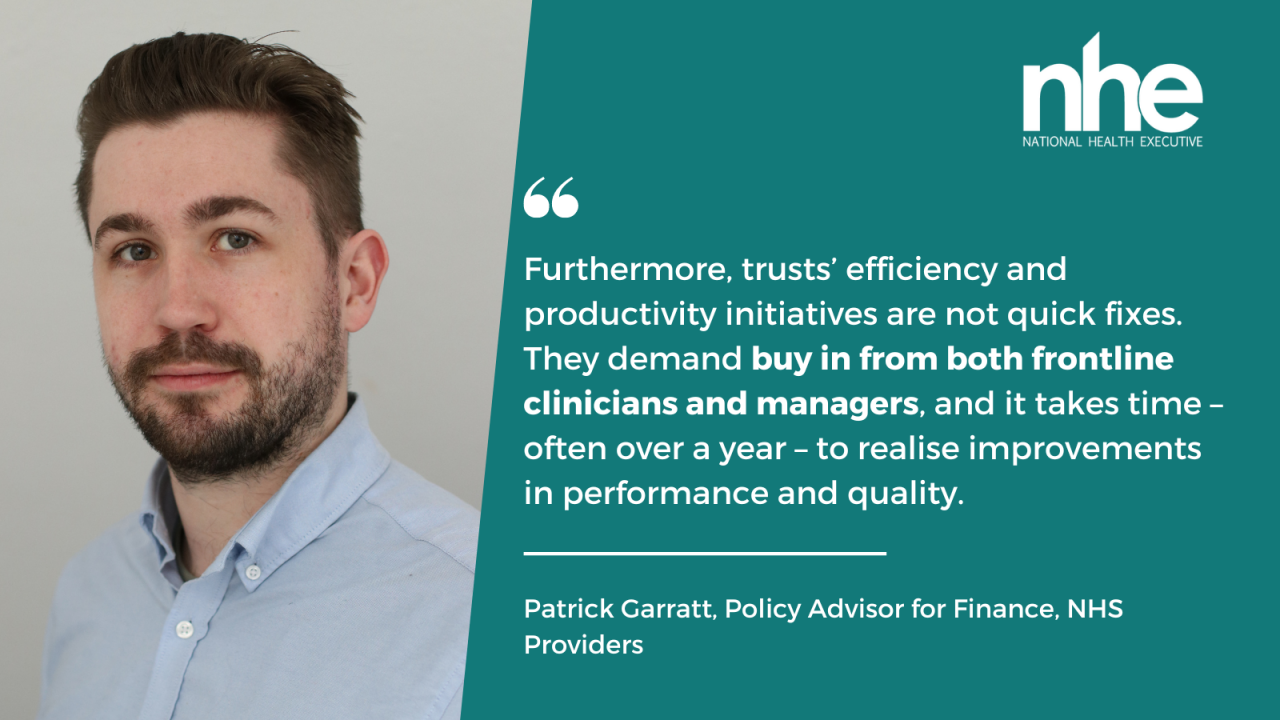In the recent autumn statement, HM Treasury placed a renewed focus on improving productivity growth across the public sector. This encompasses an ongoing review of public services productivity and will include a sharpened focus on the NHS at the Spring Budget.
It has become increasingly apparent that NHS productivity has fallen since the onset of the pandemic, though the size of the hit is contested. The picture is complex, and one that demands clarity given the mounting political pressure on NHS leaders to do more with existing resources.
Why is NHS productivity lagging behind pre-pandemic levels?
Improving ‘implied productivity’ means limiting the real terms growth in the costs of undertaking an activity (inputs) while maximising growth in activity (outputs). The NHS is spending more money and employing more staff, yet there is concern that the level of activity does not compare well to pre-pandemic levels.
This isn’t for want of trying.
Trusts continue to implement a range of productivity initiatives to increase activity growth. They are improving discharge procedures and partnerships with social care so patients can be cared for at, or closer to, home when they are ready to leave hospital; delivering different delivery models for care, including virtual wards; and working towards returning theatre utilisation to pre-pandemic levels.
Trusts employ data analytics to help reduce costs and ramp up activity. ‘Getting It Right First Time’ initiatives help trusts reduce unwarranted variation and maximise throughput, while ‘Model Health System’ data allows NHS organisations to benchmark productivity across a range of clinical and corporate services.
There are however factors outside trusts’ control which are impacting productivity growth. Trusts tell us that patients’ needs are often more complex, clinically, meaning diagnosis and care can take longer. Research from the Health Foundation shows the average patient is spending a day longer in hospital than 2019/20. However, productivity measurements often focus on the numbers of admissions rather than bed days and do not currently take into account acuity in an ageing population.
Covid-19 and rising staff sicknesses have increased trusts’ cost bases since the pandemic, while the impact of sustained industrial action has limited clinicians and managers’ ability to recover care backlogs and deliver efficiency programmes. And while additional quality and safety investments are welcomed by staff and patients – such as increasing nursing ratios – they by extension increase costs.

It is also important to note the impact of relentless operational pressures since the pandemic on discretionary effort by NHS staff. While difficult to quantify in relation to productivity growth, staff are burnt out, and understandably, less willing to work unpaid overtime to keep services going. This is borne out by the recent NHS staff survey which shows that all measures relating to burnout have remained persistently high.
What are the enablers for productivity growth?
Given how tight forecast growth for public services is after 2024/25, the sustainability of the government’s fiscal plans is contingent on a major, sustained increase in NHS labour productivity – the Long Term Workforce Plan (LTWP) assumes an annual increase between 1.5-2% per year. As the Institute for Fiscal Studies points out, this is an incredibly big ask, particularly as the Office for National Statistics estimates that ‘quality-adjusted productivity’ increased by an average 0.8% per year between 1995-96 and 2019/20.
In fact the ambitious ask set out in the LTWP is predicated on a sustained increase in capital funding to expand capacity in hospital, ambulance, community, mental health and primary care services, major digital investment throughout the NHS, and a sustainable social care sector. These are all key enablers which could help trusts to drive productivity, yet to be addressed by government in national policy making.
Furthermore, trusts’ efficiency and productivity initiatives are not quick fixes. They demand buy in from both frontline clinicians and managers, and it takes time – often over a year – to realise improvements in performance and quality.
The post-pandemic operating conditions of the NHS are markedly more challenging for providers. But with major political interest in recovering care to pre-pandemic levels, year-on-year improvement gains are at risk of being obscured. Trusts suggest we need to focus less exclusively on 2019/20 as the benchmark, and more on the resources needed in the long term to deliver sustainable efficiency savings and ramp up productivity.
Where do we go from here?
Resolving the NHS productivity challenge requires action from both trusts and government. It demands a recognition that while productivity growth is below where it was pre-pandemic, the gap may not be as large as some commentators suggest given the complexity of the metrics involved and the need to take into account patient acuity and new models of care.
We also cannot talk about productivity across the provider sector as if there is a singular, national picture. Local and regional variability is huge.
Critically, a number of the drivers of productivity still lay outside of trusts’ control. Productivity initiatives take time to come to fruition, and the key enablers require sustained government action. To help drive the productivity gains NHS leaders all want to see, sufficient capital investment, funded workforce planning and reform of social care must be key priorities for whichever party forms the next government.
Image credit: iStock



















